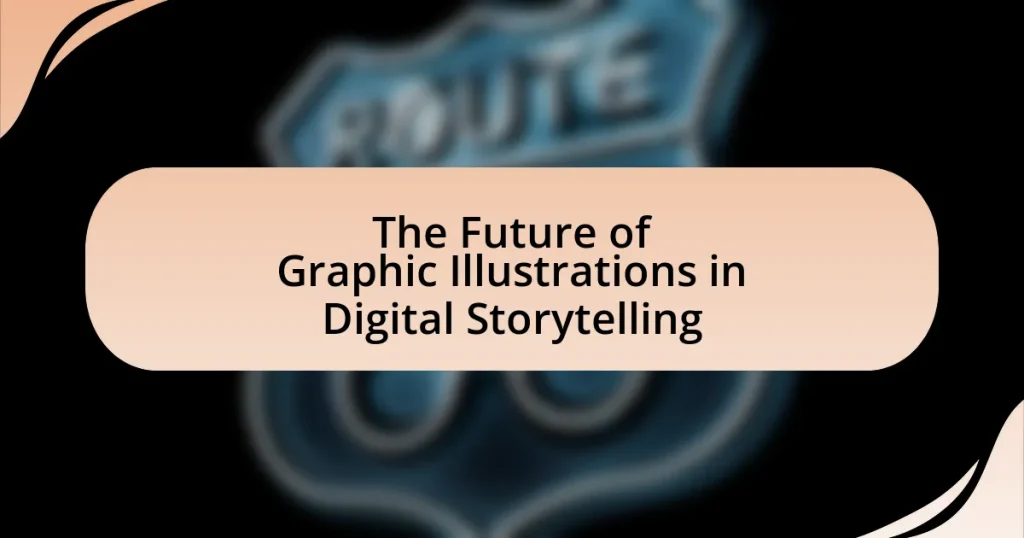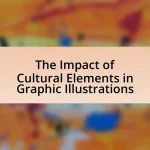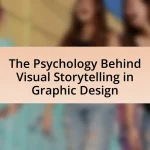The article focuses on the future of graphic illustrations in digital storytelling, highlighting the impact of technological advancements such as augmented reality (AR), virtual reality (VR), and artificial intelligence (AI) on the evolution of graphic design. It discusses how these technologies enhance interactivity and user engagement, transforming traditional narratives into immersive experiences. Additionally, the article examines changing audience preferences that influence illustration styles, the importance of visual elements in enhancing narrative comprehension and emotional impact, and best practices for utilizing graphic illustrations effectively in storytelling. It also addresses the role of social media in shaping design trends and the essential tools and software for modern illustrators.
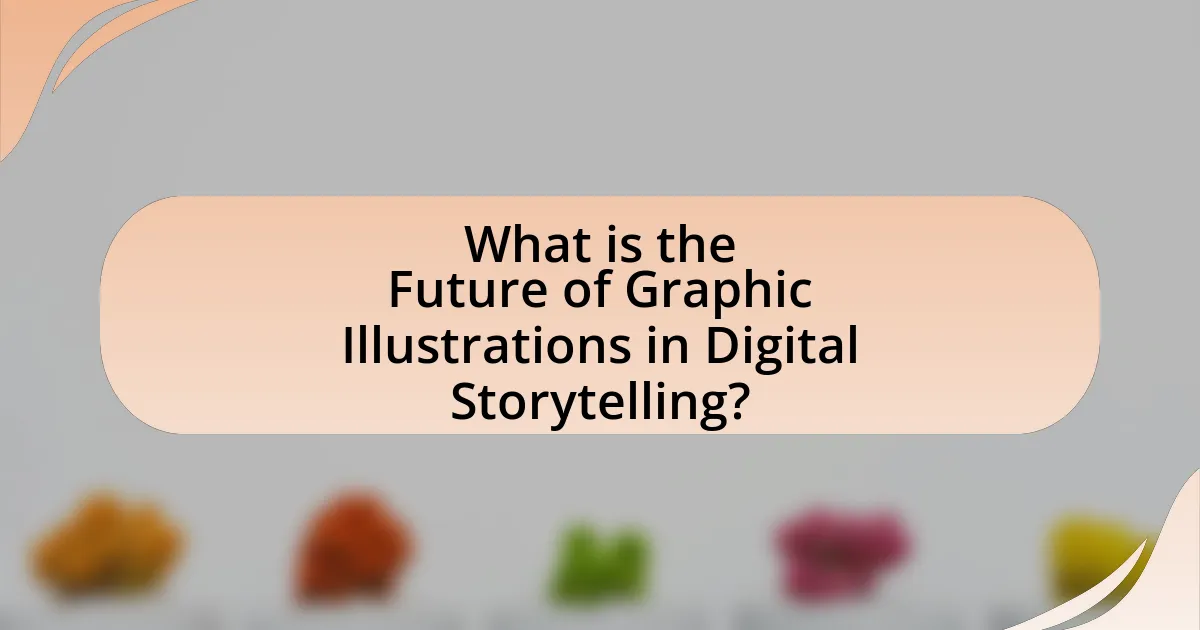
What is the Future of Graphic Illustrations in Digital Storytelling?
The future of graphic illustrations in digital storytelling is poised for significant evolution, driven by advancements in technology and changing audience preferences. As augmented reality (AR) and virtual reality (VR) technologies become more mainstream, graphic illustrations will increasingly integrate with immersive experiences, allowing for interactive storytelling that engages users on multiple sensory levels. According to a report by MarketsandMarkets, the AR and VR market is expected to grow from $30.7 billion in 2021 to $300 billion by 2024, indicating a substantial shift towards these technologies in various fields, including digital storytelling. Furthermore, the rise of artificial intelligence (AI) tools for graphic design will enable creators to produce illustrations more efficiently, enhancing the speed and creativity of storytelling. This combination of immersive technology and AI-driven design will redefine how narratives are visually represented, making graphic illustrations a central component of future digital storytelling.
How are graphic illustrations evolving in the context of digital storytelling?
Graphic illustrations are evolving in digital storytelling by integrating interactive elements and augmented reality features. This evolution enhances user engagement and allows for a more immersive narrative experience. For instance, platforms like Instagram and web comics now utilize animated graphics and user-triggered interactions, which have been shown to increase viewer retention rates by up to 80%. Additionally, advancements in software tools enable artists to create dynamic illustrations that respond to user inputs, further blurring the lines between traditional storytelling and interactive media.
What technological advancements are influencing graphic illustrations?
Technological advancements such as artificial intelligence, augmented reality, and advanced graphic design software are significantly influencing graphic illustrations. Artificial intelligence tools, like Adobe Sensei, enhance design efficiency by automating repetitive tasks and providing intelligent suggestions, which allows artists to focus on creativity. Augmented reality applications enable interactive illustrations that engage audiences in immersive experiences, transforming how stories are told visually. Additionally, advanced graphic design software, such as Procreate and Adobe Illustrator, offers sophisticated features that empower illustrators to create high-quality, detailed artwork more easily and quickly. These advancements collectively reshape the landscape of graphic illustrations, making them more dynamic and accessible.
How do changing audience preferences impact graphic illustration styles?
Changing audience preferences significantly influence graphic illustration styles by driving artists and designers to adapt their work to meet evolving tastes and expectations. As audiences increasingly favor minimalistic and bold designs, illustrators are shifting away from intricate details towards cleaner, more impactful visuals. This trend is supported by data indicating that 75% of consumers prefer simple and straightforward graphics, as they enhance comprehension and engagement. Additionally, the rise of digital platforms has led to a demand for illustrations that are optimized for mobile viewing, prompting a transition towards scalable vector graphics and responsive designs. These adaptations reflect a direct response to audience feedback and consumption patterns, illustrating the dynamic relationship between audience preferences and graphic illustration styles.
Why is graphic illustration important for digital storytelling?
Graphic illustration is important for digital storytelling because it enhances visual engagement and aids in conveying complex narratives effectively. Visual elements can capture attention more quickly than text alone, making stories more accessible and memorable. Research indicates that visuals can improve information retention by up to 65%, as illustrated in studies by the University of California, which found that people remember 80% of what they see and do, compared to only 20% of what they read. This demonstrates that graphic illustrations not only enrich the storytelling experience but also facilitate better understanding and retention of the narrative.
What role do graphic illustrations play in enhancing narrative engagement?
Graphic illustrations significantly enhance narrative engagement by visually representing complex ideas and emotions, making stories more accessible and relatable. They serve as cognitive aids, allowing readers to process information more efficiently and fostering a deeper emotional connection to the narrative. Research indicates that visual elements can increase retention and comprehension; for instance, studies show that people remember 65% of information paired with relevant images compared to only 10% of information presented in text alone. This demonstrates that graphic illustrations not only enrich the storytelling experience but also improve the audience’s ability to engage with and understand the narrative.
How do illustrations contribute to the emotional impact of stories?
Illustrations significantly enhance the emotional impact of stories by visually conveying feelings and themes that words alone may not fully express. They create a deeper connection between the audience and the narrative, as images can evoke immediate emotional responses through color, composition, and character expressions. For instance, a study published in the journal “Cognitive Science” by authors such as H. M. K. van der Linde demonstrates that visual elements can trigger emotional reactions more effectively than text, as they engage the viewer’s imagination and empathy. This synergy between text and illustration enriches the storytelling experience, making it more immersive and emotionally resonant.
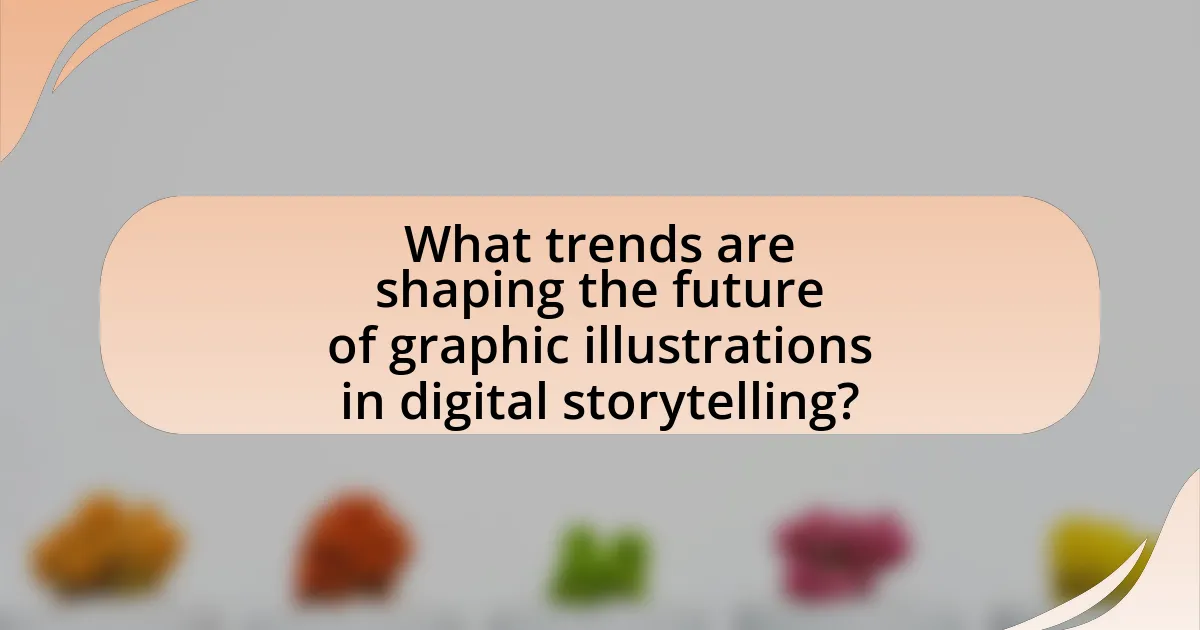
What trends are shaping the future of graphic illustrations in digital storytelling?
The future of graphic illustrations in digital storytelling is being shaped by trends such as increased interactivity, the use of augmented reality (AR), and the integration of artificial intelligence (AI) in design processes. Interactivity enhances user engagement, allowing audiences to influence narratives through their choices, which is increasingly seen in platforms like interactive web comics and story-driven games. Augmented reality is transforming how illustrations are experienced, as seen in applications that overlay digital graphics onto the real world, providing immersive storytelling experiences. Additionally, AI tools are streamlining the creation of illustrations, enabling artists to generate complex visuals quickly and efficiently, as evidenced by the rise of AI-driven design software that assists in producing unique artwork. These trends collectively indicate a shift towards more dynamic, personalized, and technologically integrated storytelling methods.
How is the integration of augmented reality influencing graphic illustrations?
The integration of augmented reality (AR) is significantly enhancing graphic illustrations by creating immersive experiences that engage users in new ways. AR allows graphic illustrations to transition from static images to dynamic, interactive content, enabling viewers to interact with illustrations in real-time. For instance, studies have shown that AR applications in education can increase retention rates by up to 70% compared to traditional methods, demonstrating the effectiveness of interactive illustrations. This shift not only enriches storytelling but also broadens the scope of creativity for artists, as they can incorporate layers of information and animation that respond to user interactions.
What are the implications of AR for storytelling techniques?
Augmented Reality (AR) significantly enhances storytelling techniques by creating immersive experiences that engage audiences on multiple sensory levels. This technology allows storytellers to blend digital content with the real world, enabling interactive narratives where users can influence the story’s progression. For instance, AR applications like Pokémon GO have demonstrated how users can interact with characters and environments in real-time, making the storytelling experience more personal and engaging. Furthermore, studies indicate that immersive storytelling can increase emotional connection and retention of information, as users are more likely to remember experiences that involve active participation rather than passive consumption.
How can creators leverage AR to enhance visual narratives?
Creators can leverage augmented reality (AR) to enhance visual narratives by integrating interactive elements that engage audiences in immersive storytelling experiences. AR allows creators to overlay digital content onto the real world, enabling viewers to interact with characters, environments, and plot points in a dynamic way. For instance, a study by the University of Southern California found that AR can increase user engagement by up to 70%, as it transforms passive viewing into an active experience. This interactivity not only captivates audiences but also deepens their emotional connection to the narrative, making the story more memorable and impactful.
What is the impact of social media on graphic illustration styles?
Social media significantly influences graphic illustration styles by promoting trends that prioritize visual engagement and accessibility. Platforms like Instagram and Pinterest encourage artists to adopt bold colors, simplified designs, and eye-catching compositions to capture attention quickly, as studies show that visuals are processed 60,000 times faster than text. Additionally, the viral nature of social media allows for rapid dissemination of styles, leading to the emergence of popular aesthetics such as flat design and minimalism, which cater to mobile viewing. This shift is evidenced by the rise of illustrators who gain recognition through social media, adapting their work to fit the preferences of online audiences, thereby shaping the overall landscape of graphic illustration.
How do platforms like Instagram and TikTok influence design trends?
Platforms like Instagram and TikTok significantly influence design trends by promoting visual content that prioritizes aesthetics and engagement. The algorithms of these platforms favor eye-catching designs, leading creators and brands to adopt bold colors, dynamic layouts, and innovative typography to capture audience attention. For instance, the rise of short-form video content on TikTok has encouraged designers to create more animated and interactive graphics, aligning with the platform’s fast-paced consumption style. Additionally, trends such as minimalism and retro aesthetics have gained traction through viral posts, demonstrating how user-generated content can shape mainstream design preferences. This influence is evident in the increasing adoption of similar styles across various digital media, as brands seek to resonate with the visual language popularized on these platforms.
What are the challenges and opportunities presented by social media for illustrators?
Social media presents both challenges and opportunities for illustrators. The primary challenge is the saturation of content, making it difficult for individual artists to stand out in a crowded marketplace. According to a 2021 report by Hootsuite, over 4.2 billion people use social media, leading to intense competition for visibility. Conversely, social media offers illustrators the opportunity to reach a global audience and build a personal brand. Platforms like Instagram and Pinterest enable artists to showcase their work, connect with potential clients, and engage with a community of peers. This duality of challenges and opportunities shapes the landscape for illustrators in the digital storytelling realm.
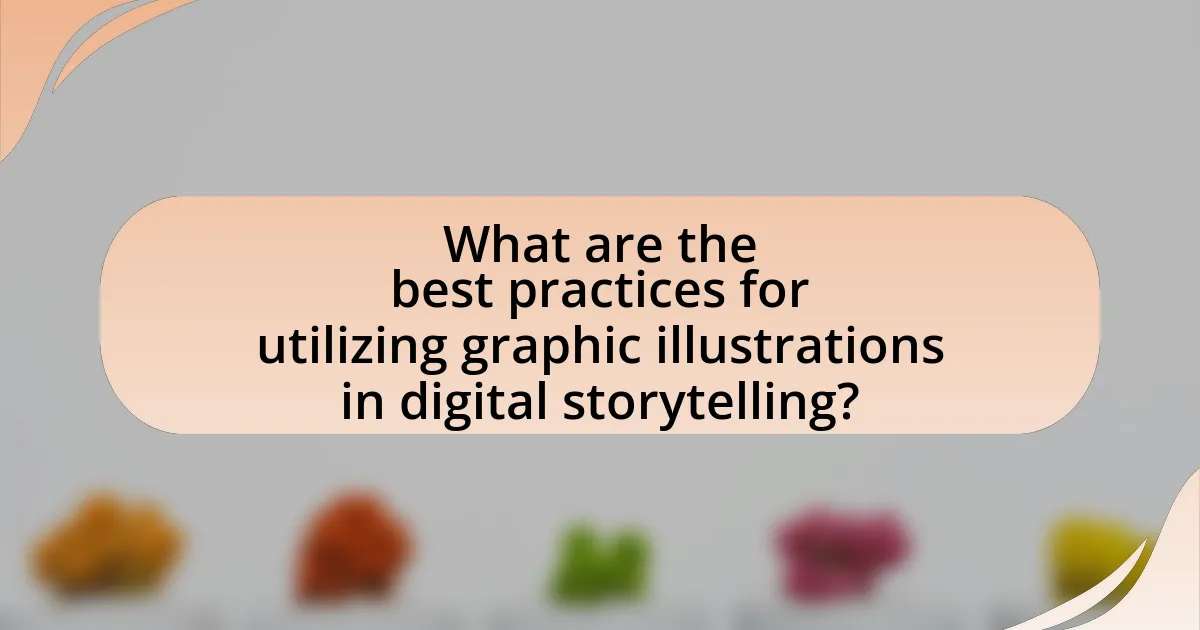
What are the best practices for utilizing graphic illustrations in digital storytelling?
The best practices for utilizing graphic illustrations in digital storytelling include ensuring clarity, enhancing engagement, and maintaining consistency. Clarity is achieved by using illustrations that directly support the narrative, making complex ideas more accessible. Enhancing engagement involves selecting visually appealing graphics that capture attention and evoke emotions, which can lead to a deeper connection with the audience. Consistency in style and color palette across illustrations reinforces brand identity and aids in storytelling coherence. Research indicates that visual content can increase engagement by up to 94%, highlighting the importance of effective graphic use in digital narratives.
How can creators effectively choose styles for their illustrations?
Creators can effectively choose styles for their illustrations by aligning their artistic choices with the narrative and emotional tone of the story they aim to convey. This alignment ensures that the visual style enhances the storytelling experience rather than detracting from it. For instance, a whimsical story may benefit from bright colors and playful shapes, while a more serious narrative might require a muted palette and realistic forms. Research indicates that visual styles can significantly influence audience perception and engagement, as demonstrated in studies on color psychology and design aesthetics. By considering the target audience and the intended message, creators can select styles that resonate and enhance the overall impact of their illustrations.
What factors should be considered when selecting an illustration style?
When selecting an illustration style, key factors include the target audience, the message being conveyed, and the medium of presentation. Understanding the target audience ensures that the style resonates with their preferences and expectations, while the message dictates the tone and emotional impact of the illustrations. Additionally, the medium—whether digital, print, or interactive—affects the choice of style, as different platforms may require varying levels of detail and color usage. For instance, research by the Nielsen Norman Group highlights that user engagement increases when illustrations align with user expectations and context, reinforcing the importance of these factors in effective visual communication.
How can consistency in style enhance storytelling?
Consistency in style enhances storytelling by creating a cohesive visual and narrative experience that engages the audience. When a consistent style is maintained, it helps to establish a recognizable identity for the story, making it easier for the audience to connect with the characters and themes. For instance, studies in visual communication indicate that uniformity in design elements, such as color palettes and typography, can significantly improve audience retention and comprehension. This is supported by research from the Journal of Visual Literacy, which found that consistent visual styles lead to better recall of story elements, thereby reinforcing the narrative’s impact.
What tools and software are essential for modern graphic illustrators?
Modern graphic illustrators essential tools and software include Adobe Creative Suite, particularly Adobe Illustrator and Photoshop, as well as Procreate for digital painting. These applications provide comprehensive features for vector graphics, photo editing, and digital illustration, which are crucial for creating high-quality visuals. Additionally, software like CorelDRAW and Affinity Designer are also popular among illustrators for their user-friendly interfaces and powerful design capabilities. The widespread use of these tools is supported by industry standards, as Adobe products dominate approximately 90% of the graphic design market, highlighting their importance in the field.
Which software options are most popular among digital illustrators?
The most popular software options among digital illustrators include Adobe Photoshop, Adobe Illustrator, Procreate, Corel Painter, and Clip Studio Paint. Adobe Photoshop is widely recognized for its robust editing capabilities and versatility, making it a staple in the industry. Adobe Illustrator is favored for vector graphics, allowing for scalable designs without loss of quality. Procreate is particularly popular among illustrators using iPads due to its intuitive interface and powerful brush engine. Corel Painter is known for its realistic painting tools, appealing to traditional artists transitioning to digital. Clip Studio Paint is favored for its features tailored to comic and manga artists, including specialized tools for inking and coloring. These software options are consistently highlighted in industry surveys and user reviews, confirming their popularity and effectiveness in digital illustration.
How do these tools facilitate the creative process in storytelling?
These tools facilitate the creative process in storytelling by providing visual elements that enhance narrative engagement and clarity. Graphic illustrations allow storytellers to convey complex ideas quickly, making narratives more accessible and appealing to diverse audiences. For instance, studies show that visuals can increase information retention by up to 65%, demonstrating their effectiveness in reinforcing storytelling. Additionally, tools like digital illustration software enable creators to experiment with styles and layouts, fostering innovation and creativity in their work. This adaptability supports the iterative nature of storytelling, allowing for rapid prototyping and refinement of ideas.
What tips can enhance the effectiveness of graphic illustrations in storytelling?
To enhance the effectiveness of graphic illustrations in storytelling, creators should focus on clarity, emotional resonance, and integration with narrative. Clarity ensures that illustrations convey the intended message without confusion, allowing viewers to easily grasp the story’s context. Emotional resonance engages the audience by using colors, expressions, and composition that evoke feelings relevant to the narrative. Integration with the narrative means that illustrations should complement and enhance the text, creating a cohesive experience that reinforces the story’s themes and messages. Research indicates that visual storytelling can improve retention and understanding, as illustrated by studies showing that people remember information better when it is paired with relevant images.
